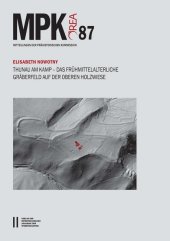 Neuerscheinungen 2018Stand: 2020-02-01 |
Schnellsuche
ISBN/Stichwort/Autor
|
Herderstraße 10
10625 Berlin
Tel.: 030 315 714 16
Fax 030 315 714 14
info@buchspektrum.de |

Karina Grömer, Barbara Horejs, Martin Jezek, Mathias Mehofer, Erich Nau, Elisabeth Nowotny, Gabriela Ruß-Popa, Sirin Uzunoglu-Obenaus
(Beteiligte)
Thunau am Kamp - Das frühmittelalterliche Gräberfeld auf der Oberen Holzwiese
Herausgegeben von Horejs, Barbara; Mitarbeit: Grömer, Karina; Jezek, Martin; Mehofer, Mathias; Nau, Erich; Ruß-Popa, Gabriela; Uzunoglu-Obenaus, Sirin
2018. 397 S. zahlr. Abb. 29.8 cm
Verlag/Jahr: VERLAG DER ÖSTERREICH. AKADEMIE DER WISSENSCHAFTEN 2018
ISBN: 3-7001-8066-7 (3700180667)
Neue ISBN: 978-3-7001-8066-1 (9783700180661)
Preis und Lieferzeit: Bitte klicken
The burial ground on the Obere Holzwiese (Thunau am Kamp) consists of 215 burials and is therefore by far the largest uncovered burial site of Carolingian times in Lower Austria north of the Danube. After it was archaeologically investigated from 1987 to 1993, the presentation of the burial ground as a whole and its scientific analysis take place in this volume. Furthermore investigations concerning archaeobotanics, material analyses, metallography, textiles and leather contributed essentially to the augmentation of knowledge.
On the Schanzberg of Thunau am Kamp a fortified central settlement, a center of power, existed in Early Medieval times. It is the only extensively excavated site of this kind in Lower Austria. The burial ground belonged to a ´manor farm´, which built the core of the site. It is to be counted to the prestige burial areas, which formed an essential part of the political centres at the eastern periphery of the Carolingian Empire.
Social affiliations of different kind find expression in burial customs, influenced by actual conditions as well as perceptions of the interred, his/her family and the local society. Thus special attention was payed to the investigation of social identities and relations of the buried, especially social status and age-specific gender roles. Burial practices deviating from the norm and multiple burials offered in particular the possibility to study underlying motivations.
Thunau was situated between the two spheres of power of the enlarged Carolingian Empire and the (Great) Moravian Empire during the 9th century and the political affiliation of extended parts of Lower Austria north of the Danube is unclear. Therefor particular attention is paid to possible assertions regarding a cultural and political orientation of the community burying here.


